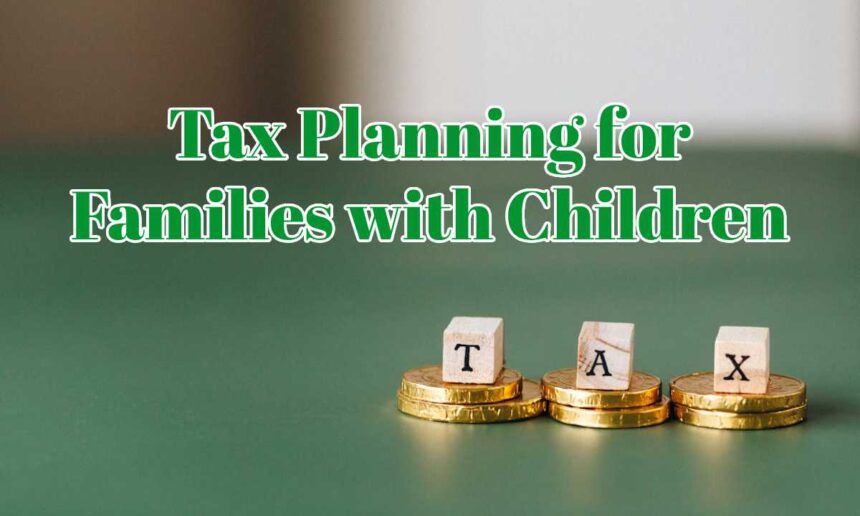Tax planning for families with children can be a complex and overwhelming task. With various tax credits, deductions, and exemptions available, understanding how to navigate the system can save you significant money. This comprehensive guide will provide you with strategies and tips to maximize your family’s tax benefits.
Understanding the Importance of Tax Planning
Tax planning is essential for families with children because it helps manage your financial resources more effectively. By taking advantage of available tax benefits, you can reduce your tax liability and increase your overall savings. Effective tax planning involves understanding your eligibility for various tax credits and deductions and implementing strategies to maximize these benefits.
Key Tax Credits for Families with Children
1. Child Tax Credit (CTC)
The Child Tax Credit is a significant benefit for families. For the tax year 2023, the maximum amount per qualifying child under age 17 is $2,000. Of this amount, up to $1,400 can be refunded if it exceeds the taxes owed. To qualify, your child must meet specific criteria regarding age, relationship, and residency.
2. Additional Child Tax Credit (ACTC)
The Additional Child Tax Credit is a refundable credit for families who did not receive the full amount from the Child Tax Credit. This credit can provide up to $1,400 per qualifying child.
3. Earned Income Tax Credit (EITC)
The Earned Income Tax Credit is designed to benefit low- to moderate-income working families. The amount you can receive depends on your income, filing status, and number of qualifying children. For the 2023 tax year, families with three or more qualifying children can receive a maximum credit of $6,935.
Deductions for Families with Children
4. Child and Dependent Care Credit
If you pay for child care so you can work or look for work, you may be eligible for the Child and Dependent Care Credit. This credit covers a percentage of your care expenses, with a maximum of $3,000 for one child and $6,000 for two or more children. The percentage of expenses you can claim depends on your income.
5. Dependent Exemption
Although the Dependent Exemption was eliminated by the Tax Cuts and Jobs Act (TCJA) from 2018 through 2025, understanding past provisions can be useful for comprehensive tax planning. It previously allowed families to deduct a set amount for each qualifying child.
Educational Tax Benefits
6. American Opportunity Tax Credit (AOTC)
The American Opportunity Tax Credit provides up to $2,500 per eligible student for the first four years of higher education. This credit covers tuition, required fees, and course materials. Up to 40% of this credit is refundable.
7. Lifetime Learning Credit (LLC)
The Lifetime Learning Credit offers up to $2,000 per tax return for tuition and related expenses. Unlike the AOTC, this credit is available for all years of post-secondary education and for courses to acquire or improve job skills.

Health-Related Tax Benefits
8. Premium Tax Credit (PTC)
Families who purchase health insurance through the Health Insurance Marketplace may qualify for the Premium Tax Credit. This credit helps cover the cost of premiums and is based on your household income and family size.
9. Medical Expense Deduction
If your medical expenses exceed 7.5% of your adjusted gross income, you can deduct the excess amount. This deduction includes payments for diagnosis, cure, mitigation, treatment, or prevention of disease, and for treatments affecting any part or function of the body.
Tax Strategies for Maximizing Benefits
10. Bunching Deductions
Bunching deductions involves timing your deductible expenses to maximize itemized deductions in one year. For example, you might pay for medical expenses, charitable contributions, or property taxes in the same year to exceed the standard deduction threshold.
11. Utilizing Flexible Spending Accounts (FSAs) and Health Savings Accounts (HSAs)
FSAs and HSAs allow you to set aside pre-tax money for medical and dependent care expenses. Contributions to these accounts reduce your taxable income, and withdrawals for qualified expenses are tax-free.
12. Saving for Education with 529 Plans
529 plans offer tax advantages for saving for education. Contributions are made with after-tax dollars, but earnings grow tax-free, and withdrawals for qualified education expenses are also tax-free.
13. Reviewing Tax Withholding
Adjusting your tax withholding can ensure you’re not overpaying or underpaying taxes throughout the year. Use the IRS’s Tax Withholding Estimator to determine the appropriate amount to withhold from your paycheck.
Common Mistakes to Avoid
14. Missing Out on Credits and Deductions
Ensure you’re aware of and claim all eligible credits and deductions. Many families miss out on benefits because they’re unaware or do not understand the requirements.
15. Not Keeping Accurate Records
Keep detailed records of all income, expenses, and tax-related documents. Good record-keeping is essential for claiming credits and deductions and for providing proof if you’re audited.
16. Filing Incorrectly
Filing your tax return incorrectly can result in delays, penalties, or missed benefits. Consider using tax software or consulting a tax professional to ensure accuracy.

Future Tax Changes to Watch
Tax laws are subject to change, and staying informed about potential changes can help you plan effectively. For example, the Child Tax Credit and other provisions from the TCJA are set to expire after 2025, which could impact your tax planning strategies.
Conclusion
Effective tax planning for families with children involves understanding and maximizing various tax credits, deductions, and strategies. By staying informed and proactive, you can significantly reduce your tax liability and increase your financial savings. Regularly review your tax situation and consult with a tax professional to ensure you’re taking full advantage of all available benefits.
By implementing these strategies and staying up-to-date with tax laws, you can ensure that you’re making the most of the tax benefits available to your family. Proper tax planning not only saves you money but also provides peace of mind, knowing that you’re managing your finances effectively for the future.
Related: Property Tax Exemption for Solar in California
Frequently Asked Questions [FAQs]
Q1: What is the Child Tax Credit and how much can I claim?
A1: The Child Tax Credit offers up to $2,000 per qualifying child under 17. Up to $1,400 is refundable, meaning you can receive it even if you owe no taxes.
Q2: How do I qualify for the Earned Income Tax Credit (EITC)?
A2: To qualify for the EITC, you must have earned income, meet income limits, and have a valid Social Security number. The credit amount varies based on income, filing status, and number of qualifying children.
Q3: What are the benefits of using a 529 plan for education savings?
A3: A 529 plan offers tax-free growth and tax-free withdrawals for qualified education expenses. It’s a great way to save for your child’s college costs.
Q4: Can I claim the Child and Dependent Care Credit if I work from home?
A4: Yes, you can claim the Child and Dependent Care Credit if you work from home, as long as you incur child care expenses to enable you to work or look for work.
Q5: What medical expenses can I deduct on my taxes?
A5: You can deduct medical expenses that exceed 7.5% of your adjusted gross income. These include payments for diagnosis, treatment, prevention of disease, and other health-related costs.
Related: What are Property Taxes at Latitude Margaritaville Hilton Head




